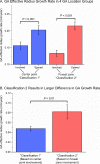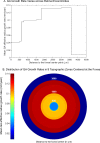Topographic Variation of the Growth Rate of Geographic Atrophy in Nonexudative Age-Related Macular Degeneration: A Systematic Review and Meta-analysis
- PMID: 31995152
- PMCID: PMC7205189
- DOI: 10.1167/iovs.61.1.2
Topographic Variation of the Growth Rate of Geographic Atrophy in Nonexudative Age-Related Macular Degeneration: A Systematic Review and Meta-analysis
Abstract
Purpose: To determine the impact of topographic locations on the progression rate of geographic atrophy (GA).
Methods: We searched in five literature databases up to May 3, 2019, for studies that evaluated the growth rates of GA lesions at different retinal regions. We performed random-effects meta-analyses to determine and compare the GA effective radius growth rates in four location groups defined by two separate classification schemes: (1) macular center point involved (CPI) or spared (CPS) in classification 1, and (2) foveal zone involved (FZI) or spared (FZS) in classification 2. We then estimated the GA growth rate in eight topographic zones and used the data to model the GA expansion.
Results: We included 11 studies with 3254 unique eyes. In studies that used classification 1, the effective radius growth rate was 30.1% higher in the CPS group (0.203 ± 0.013 mm/year) than in the CPI group (0.156 ± 0.011 mm/year) (P < 0.001). This trend became significantly more prominent in classification 2, where the growth rate was 61.7% higher in the FZS group (0.215 ± 0.012 mm/year) than in the FZI group (0.133 ± 0.009 mm/year) (P < 0.001). The estimated GA effective radius growth rates in eight retinal zones fit a Gaussian function, and the modeling of GA expansion gave rise to various GA configurations comparable to clinical observations.
Conclusions: This study indicates that the GA progression rate varies significantly across different retinal locations. Our analysis may shed light on the natural history and underlying mechanism of GA progression.
Conflict of interest statement
Disclosure:
Figures






Similar articles
-
Relationship of Topographic Distribution of Geographic Atrophy to Visual Acuity in Nonexudative Age-Related Macular Degeneration.Ophthalmol Retina. 2021 Aug;5(8):761-774. doi: 10.1016/j.oret.2020.11.003. Epub 2020 Nov 17. Ophthalmol Retina. 2021. PMID: 33212271 Clinical Trial.
-
Fellow Eye Status Is a Biomarker for the Progression Rate of Geographic Atrophy: A Systematic Review and Meta-analysis.Ophthalmol Retina. 2019 Apr;3(4):305-315. doi: 10.1016/j.oret.2018.11.013. Epub 2018 Dec 7. Ophthalmol Retina. 2019. PMID: 31014681
-
Relationship Between Presumptive Inner Nuclear Layer Thickness and Geographic Atrophy Progression in Age-Related Macular Degeneration.Invest Ophthalmol Vis Sci. 2016 Jul 1;57(9):OCT299-306. doi: 10.1167/iovs.15-18865. Invest Ophthalmol Vis Sci. 2016. PMID: 27409486
-
Increased Fundus Autofluorescence and Progression of Geographic Atrophy Secondary to Age-Related Macular Degeneration: The GAIN Study.Am J Ophthalmol. 2015 Aug;160(2):345-353.e5. doi: 10.1016/j.ajo.2015.05.009. Epub 2015 May 15. Am J Ophthalmol. 2015. PMID: 25982972 Clinical Trial.
-
The Progression of Geographic Atrophy Secondary to Age-Related Macular Degeneration.Ophthalmology. 2018 Mar;125(3):369-390. doi: 10.1016/j.ophtha.2017.08.038. Epub 2017 Oct 27. Ophthalmology. 2018. PMID: 29110945 Review.
Cited by
-
Fundus autofluorescence and optical coherence tomography biomarkers associated with the progression of geographic atrophy secondary to age-related macular degeneration.Eye (Lond). 2022 Oct;36(10):2013-2019. doi: 10.1038/s41433-021-01747-z. Epub 2021 Aug 16. Eye (Lond). 2022. PMID: 34400806 Free PMC article.
-
Geographic Atrophy: Confocal Scanning Laser Ophthalmoscopy, Histology, and Inflammation in the Region of Expanding Lesions.Invest Ophthalmol Vis Sci. 2020 Jul 1;61(8):15. doi: 10.1167/iovs.61.8.15. Invest Ophthalmol Vis Sci. 2020. PMID: 32658960 Free PMC article.
-
Central geographic atrophy vs. neovascular age-related macular degeneration: differences in longitudinal vision-related quality of life.Graefes Arch Clin Exp Ophthalmol. 2021 Feb;259(2):307-316. doi: 10.1007/s00417-020-04892-5. Epub 2020 Aug 19. Graefes Arch Clin Exp Ophthalmol. 2021. PMID: 32813108
-
A hierarchical Bayesian entry time realignment method to study the long-term natural history of diseases.Sci Rep. 2022 Mar 22;12(1):4869. doi: 10.1038/s41598-022-08919-1. Sci Rep. 2022. PMID: 35318383 Free PMC article.
-
Local Geographic Atrophy Growth Rates Not Influenced by Close Proximity to Non-Exudative Type 1 Macular Neovascularization.Invest Ophthalmol Vis Sci. 2022 Jan 3;63(1):20. doi: 10.1167/iovs.63.1.20. Invest Ophthalmol Vis Sci. 2022. PMID: 35029635 Free PMC article.
References
-
- Blair CJ. Geographic atrophy of the retinal pigment epithelium: a manifestation of senile macular degeneration. Arch Ophthalmol. 1975; 93: 19–25. - PubMed
-
- Wong WL, Su X, Li X, et al. . . Global prevalence of age-related macular degeneration and disease burden projection for 2020 and 2040: a systematic review and meta-analysis. Lancet Glob Health. 2014; 2: e106–e116. - PubMed
-
- Fleckenstein M, Mitchell P, Freund KB, et al. . . The progression of geographic atrophy secondary to age-related macular degeneration. Ophthalmology. 2018; 125: 369–390. - PubMed
-
- Lindner M, Boker A, Mauschitz MM, et al. . . Directional kinetics of geographic atrophy progression in age-related macular degeneration with foveal sparing. Ophthalmology. 2015; 122: 1356–1365. - PubMed
-
- Sunness JS, Gonzalez-Baron J, Applegate CA, et al. . . Enlargement of atrophy and visual acuity loss in the geographic atrophy form of age-related macular degeneration. Ophthalmology. 1999; 106: 1768–1779. - PubMed
Publication types
MeSH terms
Grants and funding
LinkOut - more resources
Full Text Sources

